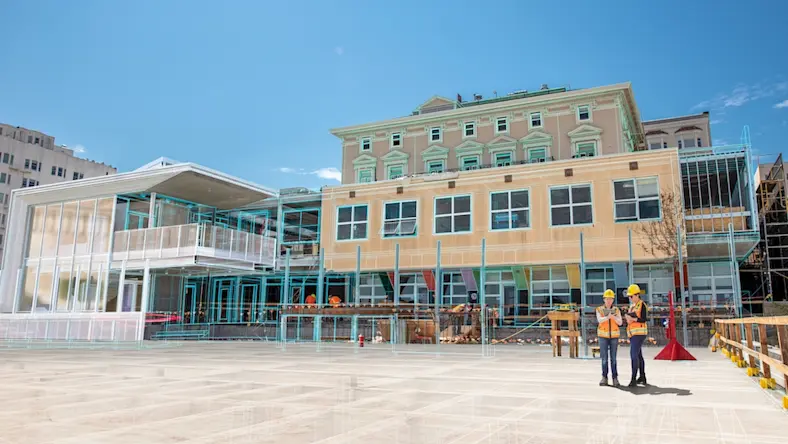& Construction

Integrated BIM tools, including Revit, AutoCAD, and Civil 3D
& Manufacturing

Professional CAD/CAM tools built on Inventor and AutoCAD
By coordinating the work of entire design and construction teams in a virtual platform with 3D models embedded with deep data on all building components, building information modeling (BIM) offers incredible advances in efficiency, clarity, and communication. But it’s also a radically different way of working from the traditional design-bid-build process, and successfully implementing BIM requires careful planning.
This sort of planning is called a BIM execution plan (BEP), and it’s essentially a roadmap of how the entire building team, including the client, will work together.
A BEP is a plan assembled by the entire building team that defines roles and responsibilities for all members: the client, architects, builders, engineers, and all manner of subcontractors. A key baseline decision is which BIM software platforms to use; other elements include project deliverables and schedules, parameters for when and how team members will share information, key project milestones, and an overall timeline. More granular elements of the BEP might include the level of visual fidelity and embedded data in models, meeting schedules, required construction tolerances, file name conventions, annotation and abbreviation protocols, quality control procedures, BIM iteration and version control procedures, and data transfer management.
Beyond making the design and construction process as efficient as possible and facilitating the completion of projects on time and on budget, the purpose of a BEP is to define and document each project’s wider goals and BIM objectives. Questions the BEP might be set up to identify include:
What does the team want to learn from this BIM experience?
How does BIM affect the design process?
Where in the process are the most time and money savings experienced?
How does BIM aid communication with nonexperts, such as clients?
How can experiences here drive efficiency and cost-effectiveness for the next project?
The BEP process is broken into two separate, contractually defined phases: pre- and post-contract plans.
The pre-contract BIM plan defines the BIM vendor’s capabilities for the building team. It answers the question, “What can your BIM process do for us?” At this phase, the BIM plan is a broad look at workflow and collaboration capabilities, with only a general sketch of milestones and schedules. It may include a project implementation plan, including IT and human-resources support capabilities.
The post-contract BIM plan codifies exactly how the BIM vendor will fulfill its capabilities. These answers are often delivered via an employee information requirements form. This BIM plan contains more detail than the previous pre-contract phase and may address communication protocols, file formats, deliverable strategies, approval protocols, file-naming conventions, meeting schedules, and more. Ultimately, this BIM plan should detail the process for timely final handover to clients.
Federal General Services Administration guidelines for BEPs call for the following information to be included:
A high-level executive summary of how BIM will be used on the project, including the team’s information needs and comprehensive, team-wide contact list.
Project goals and objectives with actionable and clear metrics
Meeting schedules
How and when model data will be exchanged
Where teams (multidisciplinary or not) will be working, whether co-located in real space or in shared virtual spaces
Quality control processes
Training resources for team members that aren’t as familiar with BIM
In 2016, Emanuele Tosatti—global channel manager at ABB Smart Building, a division of ABB Electrification—had a dream for a BIM execution plan. He envisioned digitizing ABB Electrification’s entire product portfolio and hosting it in the cloud so that the company’s customers could more easily integrate its products into their BIM models. The Swedish-Swiss energy and technology leader manufactures products including light switches, sockets, and fuse box components—pretty much everything required for a building’s electrical system.
To achieve this goal, he devised a BIM catalog containing all of the company’s products and their data sheets. This database has streamlined the workflows of architects and designers working in BIM models by providing a single source for all relevant products and their associated data—from a product’s weight to the heat it emits. “With BIM, our products are no longer simply objects; they are carriers of valuable information,” Tosatti says.
To execute the plan, ABB teamed up with Autodesk to organize joint workshops with company executives. The team used design-thinking methods to pinpoint market gaps and identify potential business. “Autodesk helped us answer questions like, ‘What kind of digital strategy do we need?’, ‘How many people are necessary?’, and ‘What technology is mandatory?’” This resulting BIM execution plan initiated the change-management process—which prepares and supports individuals, teams, and organizations in making organizational change—culminating in the digital transformation rollout.
ABB’s BIM team currently comprises several dozen professionals responsible for determining internal standards, international BIM requirements, and the necessary technology. The aim is to expand the team in order to implement BIM throughout the entire ABB Group.
Beyond the most obvious benefits of properly administered BIM—such as streamlined communications, identifying and correcting problems before committing to decisions, and better data-sharing—a BEP offers more nuanced benefits, as well. With a well-defined BEP, each team member can understand the roles everyone else is playing and see (visually and conceptually) how these roles fit together as a cohesive whole. Teams can also establish hierarchies of deadlines and set priorities when everyone is working in an environment of total data transparency with the entire process in view. BEPs also help teams establish and track metrics and expedite the onboarding process for new stakeholders who might join the project midstream. A BEP is especially critical when project teams adopt BIM for the first time, helping ease the transition by clearly defining roles and responsibilities in an unfamiliar collaborative work environment.
Confronting these growing pains is familiar ground for Eddy Slim. Trained as an architect, he has used BIM to help design some of the most high-profile cultural buildings in Mexico, such as Mexico City’s iconic Museo Soumaya art museum. In recent years, Slim has devoted his career and his company, ConstruBIM, to easing the BIM implementation process at design firms, construction companies, and governmental agencies—and managing the changes and fears that invariably come with disruption.
One of BIM’s biggest factors for successful adoption is a team’s willingness to collaborate outside of traditional silos. After making initial introductions with firm leadership, it’s important to bring everyone else into the conversation as soon as possible.
Slim gets leadership’s permission to meet with the entire staff by his third meeting with the company. “We need to talk to them because we can’t do our job if we have internal resistance,” he says. Carefully specifying how each staff member will play a part in implementing BIM gives employees a clear measure of accountability for the transition ahead. “What we try to do is specify roles and then tell everyone what their part is, and how valuable their part is to the other, so they can understand how they can collaborate and work together,” Slim says.
In terms of training, it’s key to identify the best staff members to take lead roles in managing their firm’s use of BIM. Top-level managers might not have the time or technical abilities to take on operational roles within the new system; qualified lower-level employees might actually make better BIM managers.
Once the team is assembled and ready for BIM, it’s best to start implementing the process on projects that have already begun, because new projects are more likely to get delayed or canceled. With a project already midstream, designers have a baseline level of familiarity that will see them through the uncertainty of learning a new design process—and help them see how BIM will help solve the problems they’d been struggling with using traditional methods. The transition to BIM might start by asking about pain points in the traditional design process and explaining how BIM can ease them.
People need to be reassured that BIM is most effective for saving money by cutting out time inefficiencies, not labor expenses. “Sometimes investing in BIM implementations is misunderstood as investing in workforce reduction,” Slim says. “I can see why some might think like that, but that is the wrong conclusion. BIM savings are reflected onsite, in making construction projects more efficient and better coordinated. BIM gives you access to more data and helps you avoid material waste and time-consuming mistakes.
“What we need to do is see the benefits of using BIM in terms of efficiency, in terms of speed, in terms of more information that we could analyze and solve prior to construction, which means you still need a strong team now—a big team—but your savings are reducing material waste in the construction, not in labor,” he continues.
The trick is to present BIM as offering a higher degree of control over projects—especially large-scale projects such as megabuildings. This approach demands more labor inputs that offset time-saving efficiencies, thus offering better client service. With more variables to track and more ways to track them, the more labor is invested in the model, the more everyone will get out of it.
“When we put it that way, it helps,” Slim says. “People start actually wanting to implement BIM.” And that’s another reassuring way to present BIM to teams: not as a new challenge (or aid) to designers, but as an ultimate benefit to clients.
This article has been updated. It originally published in August 2018. Friederike Voigt contributed to this article.
Zach Mortice is an architectural journalist based in Chicago.
Executive insights
Executive insights
Executive insights







